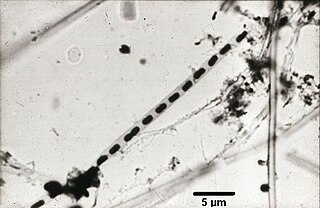
The Burkholderiales are an order of Proteobacteria. Like all Proteobacteria, they are Gram-negative. They include several pathogenic bacteria, including species of Burkholderia, Bordetella, and Ralstonia. They also include Oxalobacter and related genera, which are unusual in using oxalic acid as their source of carbon. Other well-studied genera include Alcaligenes, Cupriavidus, Achromobacter, Comamonas, Delftia, Massilia, Duganella, Janthinobacterium, Polynucleobacter, non-pathogenic Paraburkholderia, Caballeronia, Polaromonas, Thiomonas, Collimonas, Hydrogenophaga, Sphaerotilus, Variovorax, Acidovorax, Rubrivivax and Rhodoferax, and Herbaspirillum.

The Comamonadaceae are a family of the Betaproteobacteria. Like all Proteobacteria, they are Gram-negative. They are aerobic and most of the species are motile via flagella. The cells are curved rod-shaped.

Halomonadaceae is a family of halophilic Proteobacteria.

A coccobacillus, or bacilluscocco, is a type of bacterium with a shape intermediate between cocci and bacilli. Coccobacilli, then, are very short rods which may be mistaken for cocci.
Mycobacterium phlei is a species of acid-fast bacteria in the genus Mycobacterium. It is characterized as one of the fast-growing mycobacteria. M. phlei has only occasionally been isolated in human infections, and patients infected with M. phlei generally respond well to anti-mycobacterial therapy. M. phlei has an unusually high GC-content of 73%.
The Gemmatimonadota are a phylum of bacteria established in 2003. The phylum contains two classes Gemmatimonadetes and Longimicrobia.

A bacillus (pl. bacilli), or bacilliform bacterium, is a rod-shaped bacterium or archaeon. Bacilli are found in many different taxonomic groups of bacteria. However, the name Bacillus, capitalized and italicized, refers to a specific genus of bacteria. The name Bacilli, capitalized but not italicized, can also refer to a less specific taxonomic group of bacteria that includes two orders, one of which contains the genus Bacillus. When the word is formatted with lowercase and not italicized, 'bacillus', it will most likely be referring to shape and not to the genus at all. Bacilliform bacteria are also often simply called rods when the bacteriologic context is clear.
The Chloroflexota are a phylum of bacteria containing isolates with a diversity of phenotypes, including members that are aerobic thermophiles, which use oxygen and grow well in high temperatures; anoxygenic phototrophs, which use light for photosynthesis ; and anaerobic halorespirers, which uses halogenated organics as electron acceptors.
Armatimonadota is a phylum of gram-negative bacteria.
Caldithrix is a genus of thermophilic and anaerobic bacteria, currently assigned to its own phylum.

Variovorax is a Gram-negative and motile genus of bacteria from the family Comamonadaceae.
Variovorax defluvii is a Gram-negative, non-spore-forming, motile bacterium from the genus Variovorax, which was isolated from the sewage in the Geumho River in Korea.
Variovorax dokdonensis is a Gram-negative, motile bacterium from the genus Variovorax, which was isolated from soil in Dokdo in Korea. Colonies of V. dokdonensis are yellow in color.
Variovorax ginsengisoli is a Gram-negative, non-spore-forming, rod-shaped, motile bacterium from the genus Variovorax, which was isolated from soil from a ginseng field in Pocheon in South Korea. Colonies of V. ginsengisoli are yellowish in color.
Variovorax paradoxus is a gram negative, beta proteobacterium from the genus Variovorax. Strains of V. paradoxus can be categorized into two groups, hydrogen oxidizers and heterotrophic strains, both of which are aerobic. The genus name Vario-vorax and species name para-doxus (contrary-opinion) reflects both the dichotomy of V. paradoxus metabolisms, but also its ability to utilize a wide array of organic compounds.
Variovorax soli is a Gram-negative, catalase- and oxidase-positive, rod-shaped, non-spore-forming, motile bacterium from the genus Variovorax, which was isolated from greenhouse soil. Colonies of Variovorax soli are light yellow in color.
Variovorax humicola is a Gram-negative, non-spore-forming, rod-shaped and motile bacterium from the genus of Variovorax which has been isolated from forest soil near the Kyonggi University from Suwon in Korea.
Variovorax gossypii is a Gram-negative and small rod-shaped bacterium from the genus of Variovorax which has been isolated from the plant Gossypium hirsutum from Tallassee in the United States.
Variovorax guangxiensis is an aerobic bacterium from the genus of Variovorax which has been isolated from rhizosphere soil of a banana tree from Guangxi in China. Variovorax guangxiensis produces 1-aminocyclopropane-1-carboxylate deaminase.

Finnlakeviridae is a family of bacterial viruses that is not assigned to any higher taxonomic ranks. The family contains a single genus, Finnlakevirus, which contains a single species, Flavobacterium virus FLiP. This virus was isolated in 2010, with its gram-negative host bacterium, from Lake Jyväsjärvi, a boreal freshwater habitat in Central Finland, and is the first described single-stranded DNA virus with an internal membrane.






